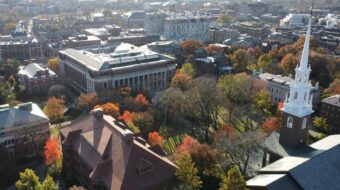
The man was well dressed, one might even say dapper. He moved to the front of the packed room with a professorial air. Born of the 19th century and known for his advocacy for social justice, he took the podium and with his mere presence held the audience in rapt attention. In the state with the “shot heard around the world” and where abolitionism had deep roots, progressive and revolutionary ideas received welcoming attention.
And it was a tumultuous time. Many were unemployed and government was not responding. The speaker was known for his antipathy toward financial institutions, the military and war. He had written much and with a literary flair about such matters.
What would be his main thrust, his focus, his analysis and solution?
Some heard the topic just before he spoke. They thought it was a joke. Some thought for sure it would be a historical disquisition on the place where they sat. It turned out to be neither. With a calm, unassuming voice, he began.
“In the earlier days, even before this anniversary we are celebrating in Massachusetts now, this valley must have been a magnificent sight. The beautiful mountains on either side thickly covered with massive trees, and in the midst of it all, the Housatonic river rolling in great flood, winding here and there, stretching now and then into lakes which are our present meadows and so hurrying always on toward the sea. And I think everyone would realize then and now that the river was the center of the picture. In a sense the mountains exist for the river; and no matter how much one might climb their sides, they look back upon the river as the central beauty of the panorama.”
Who was this man speaking so eloquently of the environment? Henry David Thoreau? Good guess but wrong. It was W.E.B. Du Bois. The educator/scholar/activist who would traverse two centuries addressing such topics as the color line, war and peace and socialism, and would eventually join the Communist Party USA, was speaking to the annual meeting of the alumni of Searles High School on July 21, 1930. The 1884 graduate of that same school in Great Barrington, Mass., went on to presage the importance of passive open space green ways and an environmental consciousness 50 years ahead of its time.
“What has happened? The thing that has happened in this valley has happened in hundreds of others. The town, the whole valley, has turned its back upon the river. They have sought to get away from it. They have neglected it. They have used it as a sewer, a drain, a place for throwing their waste and their offal. Mills, homes, and farms have poured their dirt and refuse into it; outhouses and dung heaps have lined its banks. Almost as if by miracle some beauty still remains in places where the river for a moment free of its enemies and tormentors, dark and exhausted under its tall trees, has sunk back to vestiges of its former charm, in great, slow, breathless curves and still murmurs. But for the most part the Housatonic has been transformed into an ugly disgraceful thing. We have crossed it with bridges of unbelievable ugliness, we have choked the flow of its waters, and we have done this not only by filling up the river with refuse, but by denuding the guardian hillsides of their trees and shutting off the brooks.”
Du Bois went on to mention rivers of other countries. He emphasized while they were used as highways, people cultivated and appreciated their beauty. He continued,
“You know we are judged by what we neglect. … Perhaps the very freeing of spirit which will come from giving up our attempt to do the impossible, from our ignoring of our greatest source of beauty and completeness, and degrading it with filth and refuse, perhaps from that very freeing of spirit will come other freedoms and inspirations and aspirations which may be steps toward the whole vast problem of country life and the diffusion and diversification and enriching of culture throughout this land. Even if this vision sounds fantastic to the severely practical, certainly the cleansing of the Housatonic will mean better health, less typhoid, safer recreation and lovelier vistas of beauty.”
He urged “that we should rescue the Housatonic and clean it as we have never in all the years thought before of cleaning it, and seek to restore its ancient beauty; making it the center of a town, of a valley, and perhaps — who knows? of a new measure of civilized life.”
All too often powerful voices for social justice from our past are not recognized for the completeness of their vision for a better world. And those visions include the environment. This is doubly so for African American activists and thinkers.
This was not a “one shot deal” on the environment for W.E.B. Du Bois. In 1961, at the time he joined the Communist Party, he wrote the same Great Barrington Alumni Association about the Housatonic River and the environment.
Fortunately, some 30 years later, environmentalists, inspired by Du Bois’ eloquent words and vision, went to work. By the new millennium, 1,900 volunteers, with more than half school-age children and young adults, transformed the riverbank, removing 365 tons of debris, planting native flora and initiating a half-mile public walking trail. On Sept. 28, 2002, the W.E.B Du Bois River Garden was dedicated just a few paces from his birthplace.
In these times of hope and political change, Great Barrington’s river walk and the Dubois River Garden are beautiful destinations for all activists. While there, be sure to rekindle Dr. Du Bois’ other visions of peace and social justice.
For more information and pictures of the Du Bois River Garden and public river walk go to https://gbriverwalk.org/historic-places/du-bois-river-park/.
Art Perlo contributed research for this article.

MOST POPULAR TODAY


Zionist organizations leading campaign to stop ceasefire resolutions in D.C. area

Afghanistan’s socialist years: The promising future killed off by U.S. imperialism

High Court essentially bans demonstrations, freedom of assembly in Deep South

Communist Karol Cariola elected president of Chile’s legislature






Comments